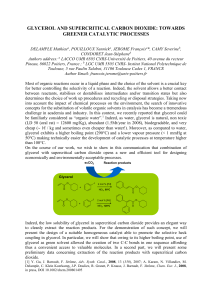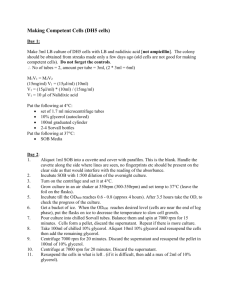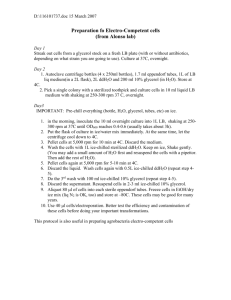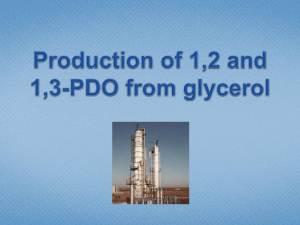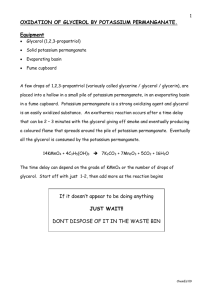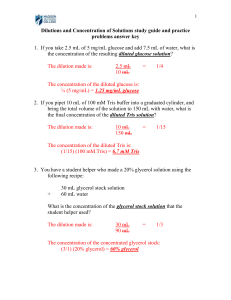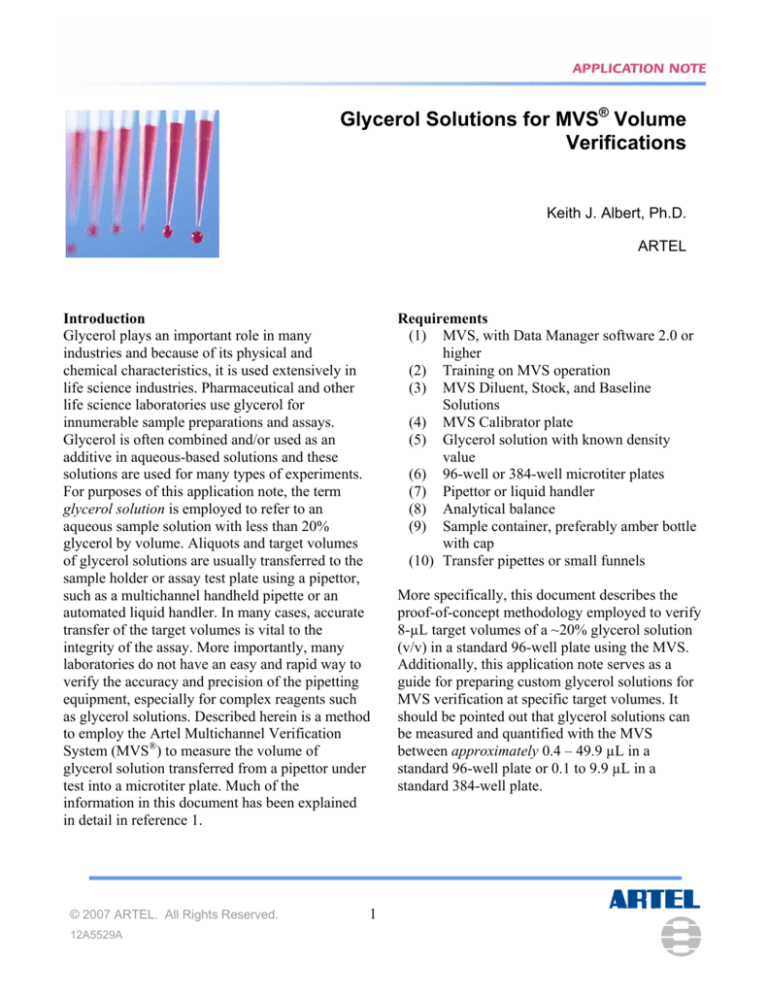
Glycerol Solutions for MVS® Volume
Verifications
Keith J. Albert, Ph.D.
ARTEL
Introduction
Glycerol plays an important role in many
industries and because of its physical and
chemical characteristics, it is used extensively in
life science industries. Pharmaceutical and other
life science laboratories use glycerol for
innumerable sample preparations and assays.
Glycerol is often combined and/or used as an
additive in aqueous-based solutions and these
solutions are used for many types of experiments.
For purposes of this application note, the term
glycerol solution is employed to refer to an
aqueous sample solution with less than 20%
glycerol by volume. Aliquots and target volumes
of glycerol solutions are usually transferred to the
sample holder or assay test plate using a pipettor,
such as a multichannel handheld pipette or an
automated liquid handler. In many cases, accurate
transfer of the target volumes is vital to the
integrity of the assay. More importantly, many
laboratories do not have an easy and rapid way to
verify the accuracy and precision of the pipetting
equipment, especially for complex reagents such
as glycerol solutions. Described herein is a method
to employ the Artel Multichannel Verification
System (MVS®) to measure the volume of
glycerol solution transferred from a pipettor under
test into a microtiter plate. Much of the
information in this document has been explained
in detail in reference 1.
© 2007 ARTEL. All Rights Reserved.
12A5529A
1
Requirements
(1) MVS, with Data Manager software 2.0 or
higher
(2) Training on MVS operation
(3) MVS Diluent, Stock, and Baseline
Solutions
(4) MVS Calibrator plate
(5) Glycerol solution with known density
value
(6) 96-well or 384-well microtiter plates
(7) Pipettor or liquid handler
(8) Analytical balance
(9) Sample container, preferably amber bottle
with cap
(10) Transfer pipettes or small funnels
More specifically, this document describes the
proof-of-concept methodology employed to verify
8-µL target volumes of a ~20% glycerol solution
(v/v) in a standard 96-well plate using the MVS.
Additionally, this application note serves as a
guide for preparing custom glycerol solutions for
MVS verification at specific target volumes. It
should be pointed out that glycerol solutions can
be measured and quantified with the MVS
between approximately 0.4 – 49.9 µL in a
standard 96-well plate or 0.1 to 9.9 µL in a
standard 384-well plate.
Materials & Methods
All purchased materials were used as received.
Glycerol (Biochemika Ultra; 1.262 g/mL, MW
92.10 g, C3H8O3) was acquired from SigmaAldrich. The MVS and all MVS-related
consumables were from Artel (Westbrook, ME). A
Sartorius R160D analytical balance was employed
for all gravimetric determinations. All solutions
were allowed to equilibrate to room temperature
prior to being used. All solution components were
transferred to the analytical balance with
disposable transfer pipettes and subsequently
weighed on the analytical balance. Following each
component addition, the balance was allowed to
reach equilibrium, the information was collected
and the balance was tared before the next
component was added. In all cases, a clean, amber
glass bottle and cap were used to prepare and store
the glycerol solutions. Once all components were
added, the bottle was mixed by inversion at least
20 times.
Proof-of-concept Testing
To verify the 8-µL transfer of a ~20% glycerol
solution (v/v) in a 96-well plate, four steps were
performed: (a) an initial 21% glycerol solution
(v/v) was prepared; (b) this glycerol solution was
gravimetrically-combined, and therefore slightly
diluted, with MVS Stock Solution to prepare the
glycerol (alternative) test solution; (c) the weight
and density of the glycerol solution and weight of
the MVS Stock Solution were incorporated into
the MVS Data Manager software; and (d) the
prepared glycerol test solution was dispensed with
the liquid handler followed by volume verification
and analysis using the MVS. These four steps are
summarized in Figure 1 and are described in more
detail below.
© 2007 ARTEL. All Rights Reserved.
12A5529A
MVS Stock Solution (1 or 2) with known
density and absorbance per pathlength
value(s)
Glycerol Solution with known
density
Using instructions, gravimetrically combine
the MVS Stock Solution and Glycerol
Solution in a controlled weight (mass) ratio to
create the GLYCEROL TEST SOLUTION
Multichannel dispensing device –
automated liquid handler
Glycerol Test Solution is dispensed into a
microtiter plate (96-well or 384-well).
Diluent is added to create a working
volume for the verification process
The Glycerol Test
Solution has new
absorbance per
pathlength value(s)
calculated from the
dilution ratio
Reagents in plate are mixed and plate is placed in
plate reader
Dual-dye ratiometric photometry used to quantify
dispensed volume in each well
Figure 1. Overview of the method used to prepare and
verify target volumes of glycerol solutions using the
MVS
(a) Preparation of a ~20% glycerol solution (v/v).
For proof-of-concept testing, the initial glycerol
solution was simply a combination of deionized
water and glycerol. In many cases, the user will
have the glycerol solution readily available. A
21.4% glycerol solution (v/v), or 25.6% glycerol
by mass, was prepared by combining 8.6293 g
glycerol with 25.0169 g deionized water (33.6462
g total). Note, the density value of pure glycerol is
approximately 1.262 g/mL and this value was used
to calculate the amount of glycerol in the prepared
glycerol solution. See Figure 2 for the preparation
details for the initial glycerol solution. In order for
a target volume of this solution to be verified with
the MVS’ photometric technology, gravimetric
combination with an MVS Stock Solution must be
achieved, i.e., MVS dye must be added to the
glycerol solution to enable photometric
measurement of target volumes.
For preparing other glycerol solutions at varying
concentrations, or to obtain the approximate
density values for solutions with 0.5% – 20%
glycerol (v/v), please refer to Table 1 at the end of
this document.
2
This glycerol test solution is then dispensed into a
microtiter plate for volume verification and
analysis with the MVS. For preparing other
glycerol test solutions with varying amounts of
glycerol, or to obtain information on the
approximate amount of MVS Stock Solution 1 or
2 to add to the glycerol solution, please refer to
Table 2 at the end of this document.
Figure 2. Details for the preparation of the
initial 21% glycerol solution (v/v).
(b) Preparation of the glycerol test solution. Using
easy-to-follow instructions3, the prepared 21%
glycerol solution (v/v) was combined with MVS
Stock Solution 1 to create the glycerol
“alternative” test solution. The process is
summarized in Figure 3. The term alternative is
used in the MVS Data Manager software to
describe a custom test solution that is
chemically different from the commerciallyavailable, aqueous-based MVS Sample
Solutions. For purposes of this application note,
the custom alternative test solution prepared with
glycerol is simply referred to as the glycerol test
solution.
Figure 3. Overview of the preparation of the
glycerol test solution from the glycerol solution
and the MVS Stock Solution.
© 2007 ARTEL. All Rights Reserved.
12A5529A
3
(c) Enter necessary information into MVS Data
Manager software. The density value of the
prepared 21.4 % glycerol solution (v/v) is
approximately 1.06 g/mL2. In the case presented
here, all of the glycerol solution (33.6462 g) was
combined with 3.5189 g MVS Stock Solution 1 in
an amber glass bottle to prepare the glycerol test
solution. The weight and density values of the
glycerol solution and the weight of MVS Stock
Solution 1 were entered into the MVS Data
Manager software. The dye concentration in the
final, glycerol test solution is calculated based on
the dilution ratio of the MVS Stock Solution 1 to
glycerol solution. In the example discussed here,
as shown in Figure 4, the resulting glycerol test
solution is comprised of 9.9 % of MVS Stock
Solution 1 (v/v) and 90.1 % of the initial 21%
glycerol solution (v/v).
The resulting glycerol test solution therefore had a
final glycerol concentration of 19.34 % (v/v).
Note, 90.1% of a 21.47 % glycerol solution is
equal to 19.34 % glycerol in the test solution. This
19.34% glycerol test solution (v/v) was designed
and prepared to incorporate similar absorbance per
pathlength values as the commercially-available
aqueous MVS Sample Solutions1. For example,
the volume range for the custom solution
described herein is similar to the aqueous-based
MVS Range C Sample Solution, which covers 2.0
– 9.9 µL in a 96-well plate.
thereby removing device variability from the test
procedure. The gravimetrically-calibrated 8-µL
Hamilton (Reno, NV) syringes with
reproducibility adapters were used to aspirate
target volume from a vial filled with the 19.34%
glycerol test solution followed by a dispense into a
96-well microtiter plate. To each well containing
the target volume, 192 µL of MVS Diluent
solution was added to achieve a 200-µL working
volume4 in the 96-well plate. The two solutions in
each well were mixed using the MVS plate shaker
before the plate was placed into the MVS plate
reader for measurement.
Figure 4. Graphical user interface for preparing
custom test solutions in MVS Data Manager
software. The weight and density values of the MVS
Stock Solution 1 and glycerol solution are employed
to calculate the usable volume range for various
plate formats. For example, the proof-of-concept
glycerol test solution shown can be dispensed from a
liquid handler into a 96-well plate and the target
volume can be assessed with the MVS for accuracy
and precision between 1.8 – 10.9 µL or between 0.5
– 2.8 µL in a standard 384-well plate.
(d) Transfer and performance analysis of
prepared glycerol test solution. After the
necessary information (weights, density values)
was entered into the MVS Data Manager software,
8 µL target volumes of the prepared glycerol test
solution were dispensed into a microtiter plate for
MVS volume verification and analysis. The proofof-concept testing for this solution was performed
with calibrated syringes. All syringes are
gravimetrically-calibrated using an accredited
method in a controlled test laboratory. Because the
reproducibility of the syringes has been proven,
they can be used as volume transfer standards
© 2007 ARTEL. All Rights Reserved.
12A5529A
4
Results and Conclusions
The 19.34 % glycerol test solution (v/v) was
employed to monitor solution stability over time.
Using the calibrated 8-µL Hamilton syringe with
modified reproducibility adapter, the solutions
were dispensed in replicates of eight into a 96-well
Artel Verification Plate on each day of testing.
The stability, or shelf-life, of the prepared test
solutions, as monitored by relative inaccuracy (all
values are within ± 1.7 %), shows that the glycerol
test solution was stable for at least four weeks.
The coefficient of variation (%CV) values, or the
precision data in the measurement, were within ±
0.5 % (Figure 5). These results indicate that it
may be possible for individual users to employ
this methodology to assess device performance for
specific or proprietary glycerol solutions for
critical volume transfers.
Discussion
The proof-of-concept for preparing and verifying
dispensed target volumes of the 19.34% glycerol
test solution (v/v) has been shown. Although this
application note does not discuss the preparation
or testing of other glycerol test solutions, i.e.,
2.0%
Relative Inaccuracy %
CV%
MVS Measurement Results (%)
1.5%
1.0%
0.45%
0.31%
0.5%
0.34%
0.25%
0.23%
0.0%
0
5
10
15
20
25
30
-0.5%
-1.0%
-1.5%
-1.18%
-1.48%
-1.17%
-1.23%
-1.62%
-2.0%
-2.5%
-3.0%
Please note, the final glycerol test solution will
have a lower concentration of glycerol as
compared to the initial glycerol solution because
of the addition of the aqueous-based MVS Stock
Solution. For instance, a 24 % glycerol solution by
mass (or 20 % glycerol by volume), may be
diluted to approximately: (a) ~ 18 % glycerol by
mass for target volumes between 0.4 – 4 µL in 96well plates; (b) ~22 % glycerol by mass for target
volumes between 2 – 11 µL in 96-well plates; or
(c) ~ 19 % glycerol by mass for target volumes
between 9 – 49 µL in 96-well plates. These values
are from column k in Tables 1 and 2.
Time (days)
Figure 5. Using an 8-µL calibrated syringe, the 19.34%
glycerol test solution was verified on five different days over
a 28-day period. Based on the relative inaccuracy values, the
shelf-life of the solution may be at least 4 weeks.
solutions with < 20 % glycerol by volume, the
functionality in the MVS Data Manager software
does support trial-and-error experimentation for
users that wish to test their specific glycerol
solutions. Alternative test solutions containing >
20% glycerol (v/v) have not been evaluated by
Artel.
Table 1 (below) can be used as a guide for
preparing glycerol solutions when glycerol
portions are < 24 % by mass (or < 20 % by
volume). Table 2 (below) can be used as a guide
for adding the appropriate amount and type of
MVS Stock Solution to the glycerol solution to
prepare an appropriate glycerol test solution that
covers a specific volume range in either 96-well or
384-well standard profile plates. For example,
preparing a glycerol test solution that covers 5 µL
in a standard 96-well plate is different than
preparing a glycerol test solution that covers 5 µL
in a standard 384-well plate.
© 2007 ARTEL. All Rights Reserved.
12A5529A
5
References
(1)
Albert, K.J.; Bradshaw, J.T.; Knaide, T.R.; Rogers,
A.L. Verifying Liquid Handler Performance for
Complex or Non-Aqueous Reagents: A New
Approach. J. Assoc. Lab. Autom., 2006, 11, 172-180.
(2)
Handbook of Chemistry and Physics, 78th Edition,
CRC Press, New York, David R. Lide, Editor-inChief, 1997-1998.
(3)
Protocols and information for determining the proper
amount of MVS Stock Solution to add to the
corresponding amount of Solvent (or starter) Solution
are detailed in multiple places, including the MVS
User Guide, the MVS Help menu (MVS Data
Manager software 2.0 and higher), as well as the
Alternative Solution Helper software program found
as part of MVS Data Manager 2.2 and higher.
Additionally, Artel Technical Support can be
contacted with any questions between 8 am – 5 pm
EST (888.406.3463 x109) or via email at
technical.support@artel-usa.com.
(4)
Bradshaw, J. T.; Knaide, T.; Rogers, A.; Curtis, R. H.
Multichannel Verification System (MVS): A DualDye Ratiometric Photometry System for Performance
Verification of Multichannel Liquid Delivery
Devices. J. Assoc. Lab. Autom., 2005, 10, 35-42.
An example in using these tables: verify a 5-µL transfer of a
15% glycerol solution (g/g) in a 96-well plate. Refer to
column i. In this case, to the 50 g of 16% glycerol solution
(g/g), add 5.299 g MVS Stock Solution 1. The resulting test
solution will be approximately 14.5% glycerol by mass. If a
higher percent of glycerol is desired in the final glycerol test
solution, a higher concentration of glycerol is required in the
original glycerol solution.
© 2007 ARTEL. All Rights Reserved.
12A5529A
For instance, to measure a 1-µL dispense of a 15% glycerol
solution (g/g) in a 96-well plate, the solution in column j
could be prepared. To the 50 g of the 20% glycerol solution
(g/g), add 16.121 g of MVS Stock Solution 1 resulting in a
15.1% glycerol test solution (g/g).
6
25 Bradley Drive
Westbrook, ME 04092-2013
toll-free: 888-406-3463
tel: 207-854-0860
fax: 207-854-0867
email: info@artel-usa.com
web: www.artel-usa.com


